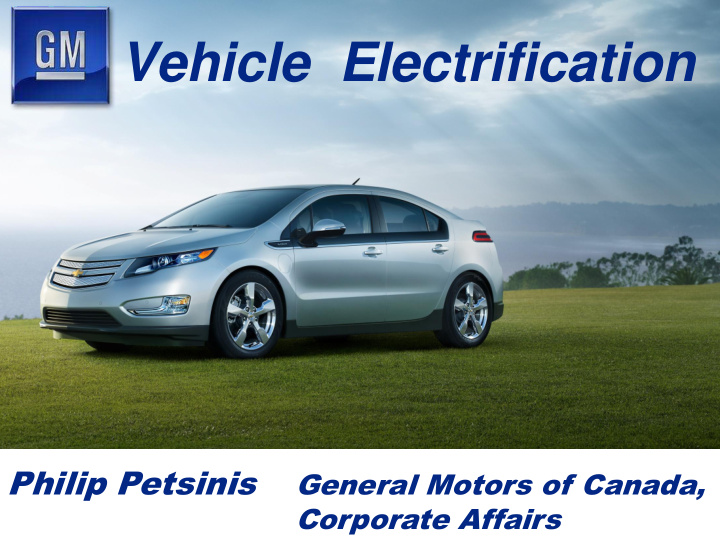



Vehicle Electrification Philip Petsinis General Motors of Canada, Corporate Affairs
Current Situation Market Challenges U.S. housing crisis Credit / Liquidity crisis U.S. New Vehicle Market Collapse Volatility of fuel prices Global cost competition Dramatic FE Regulations Changes
Increasing Electrification
Engine Generator Lithium-Ion Battery Electric Drive Unit Charge Port
Cells Are the Building Blocks of the Battery Pack • All lithium-ion chemistries are not alike • Characteristics required for automotive applications differ greatly from consumer electronics • More than 200 cells • Volt Batter will have 16 kwh of energy storage Capacity • Thermally managed through liquid heating and cooling
VOLT Lithium-Ion Battery 288 Cells Module 70% of the Cost Pack
Creating a new propulsion category: Electric Vehicle with Extended-Range
Overcoming RANGE Anxiety
Electric Vehicle with EXTENDED-RANGE 64 HUNDREDS km of km BATTERY EXTENDED RANGE Electric Driving Electric Drive
Typical Commute Why Target 40Miles / 64 Km? 78% of customers commute 40miles/64km or less daily Based on U.S. Department of Transportation 2003 Omnibus Household Survey
Volt’s EV CO 2 Performance based on Ontario’s Electrical Mix 300 Fuel Lifecycle CO 2 Emissions (g/km) 250 Volt emits 6% of the fuel 200 lifecycle GHG emissions of a comparable fuel efficient gasoline vehicle 150 Volt emits 1/8 th or 100 12% of the fuel lifecycle GHG emissions of most 50 fuel efficient Hybrid 0 Volt Toyota Prius Chevrolet Cobalt Chevrolet Malibu Leading Hybrid Vehicle Model
Operating Costs 85¢/L = 4 ¢ per KM 1¢ per KM off-peak 1.30$/L = 6 ¢ per KM (2¢ on-peak)
Charging Power Levels • 120V (1.2 kW) charging – Plugs into standard household outlet – Full charge in about 8 hours – No additional equipment or installation 120V Cordset – Charge cord comes standard with the vehicle • 240V (3.3 kW) charging – Full charge in about 3 hours – Increased convenience and enables more off-peak charging – Will require a one-time investment to upgrade garage with dedicated 240V circuit • Charger and control logic onboard the vehicle 240V Charge • Designed for global voltages Station
Volt Smart Charging Functionality Volt charging options move customers away from peak charging, result in a “stagger” that prevents a new evening peak, and includes manual programmable features that anticipate the more automatic "smart grid" features to come.
Source of Data - 2001 National Household Travel Survey ; GM Data Analysis (Tate/Savagian) - SAE paper 2009-01-1311 Where Are the Cars for Charging? 100.00% 10.00% 20.00% 30.00% 40.00% 50.00% 60.00% 70.00% 80.00% 90.00% 0.00% Sunday 04:00 Sunday 08:00 Sunday 12:00 Sunday 16:00 Sunday 20:00 Home Monday 00:00 Monday 04:00 Monday 08:00 Monday 12:00 Residence Monday 16:00 Monday 20:00 Fleet Distribution during week Tuesday 00:00 Tuesday 04:00 Tuesday 08:00 Work Tuesday 12:00 Tuesday 16:00 Tuesday 20:00 School & Church Wednesday 00:00 Wednesday 04:00 Wednesday 08:00 Wednesday 12:00 Wednesday 16:00 Wednesday 20:00 Thursday 00:00 Commercial Thursday 04:00 Thursday 08:00 Thursday 12:00 Thursday 16:00 Thursday 20:00 Friday 00:00 Other Friday 04:00 Friday 08:00 Friday 12:00 Driving Friday 16:00 Friday 20:00 Saturday 00:00 Saturday 04:00 Saturday 08:00 Saturday 12:00 Saturday 16:00 Saturday 20:00 Sunday 00:00
Charging Infrastructure • Public – High Visibility – Commercial/Retail Public Public – Public Education and Outreach • Workplace – Corporate, Municipal Parking Lots Workplace • Residential (majority) – Satisfying consumer-driven home installation process – Permits, electricians, Residential inspections, meters, rates
GM/EPRI Utility Collaboration Includes more than 50 Utilities… many the industry’s thought - leaders in electric transportation and grid interaction BC Hydro Manitoba Hydro Snohomish County PUD No. 1 Seattle City Light Hydro-Québec Avista Corp. Portland General Electric NY ISO PacifiCorp Great River Energy Central Hudson G&E Hydro One Northeast Utilities Consumers Energy Rochester G&E United Illuminating Dairyland Power We Energies NYPA ConEd EnWin DTE LIPA Madison G&E PJM Nebraska Public Power Dist. PSEG Exelon FirstEnergy Constellation Energy Sacramento Municipal UD Lincoln Electric AEP Pepco Holdings, Inc. Hetch Hetchy Water and Power Hoosier Tri-State G&T Great Plains Energy Dominion Resources Pacific Gas & Electric Ameren Duke Energy Services Southern California Edison Progress Energy Salt River Project Tennessee Valley Authority Arizona Public Service Arkansas Electric Coop San Diego Gas & Electric Southern Company EUROPE Iberdrola, S.A. Austin Energy Golden Valley Electric Assn. CenterPoint Energy CPS Energy Hawaiian Electric Co.
Plug-in Ready Communities Required Stakeholders Desired Enablers • Dedicated project leader Infrastructure/Incentives/Educational Outreach • Provinces, Fed, Cities, Municipalities Vehicle Charging installation purchase • Clean Cities Orgs incentives incentives (home, work, public) • Utilities, Generators Low off-peak charging rates Green charging • Regulators/public utility Building codes options commissions and home Government fleet charging enablers • Permitting and code officials purchases • Major employers HOV lane Free Free access parking charging • Local universities
Vehicle Electrification
Recommend
More recommend